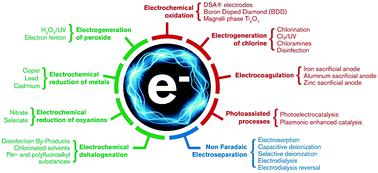当前位置:
X-MOL 学术
›
Environ. Sci.: Nano
›
论文详情
Our official English website, www.x-mol.net, welcomes your
feedback! (Note: you will need to create a separate account there.)
Opportunities for nanotechnology to enhance electrochemical treatment of pollutants in potable water and industrial wastewater – a perspective
Environmental Science: Nano ( IF 5.8 ) Pub Date : 2020-06-19 , DOI: 10.1039/d0en00194e Sergi Garcia-Segura, Xiaolei Qu, Pedro J. J. Alvarez, Brian P. Chaplin, Wei Chen, John C. Crittenden, Yujie Feng, Guandao Gao, Zhen He, Chia-Hung Hou, Xiao Hu, Guibin Jiang, Jae-Hong Kim, Jiansheng Li, Qilin Li, Jie Ma, Jinxing Ma, Alec Brockway Nienhauser, Junfeng Niu, Bingcai Pan, Xie Quan, Filippo Ronzani, Dino Villagran, T. David Waite, W. Shane Walker, Can Wang, Michael S. Wong, Paul Westerhoff
Environmental Science: Nano ( IF 5.8 ) Pub Date : 2020-06-19 , DOI: 10.1039/d0en00194e Sergi Garcia-Segura, Xiaolei Qu, Pedro J. J. Alvarez, Brian P. Chaplin, Wei Chen, John C. Crittenden, Yujie Feng, Guandao Gao, Zhen He, Chia-Hung Hou, Xiao Hu, Guibin Jiang, Jae-Hong Kim, Jiansheng Li, Qilin Li, Jie Ma, Jinxing Ma, Alec Brockway Nienhauser, Junfeng Niu, Bingcai Pan, Xie Quan, Filippo Ronzani, Dino Villagran, T. David Waite, W. Shane Walker, Can Wang, Michael S. Wong, Paul Westerhoff

|
Based upon an international workshop, this perspective evaluates how nano-scale pore structures and unique properties that emerge at nano- and sub-nano-size domains could improve the energy efficiency and selectivity of electroseparation or electrocatalytic processes for treating potable or waste waters. An Eisenhower matrix prioritizes the urgency or impact of addressing potential barriers or opportunities. There has been little optimization of electrochemical reactors to increase mass transport rates of pollutants to, from, and within electrode surfaces, which become important as nano-porous structures are engineered into electrodes. A “trap-and-zap” strategy is discussed wherein nanostructures (pores, sieves, and crystal facets) are employed to allow localized concentration of target pollutants relative to background solutes (i.e., localized pollutant trapping). The trapping is followed by localized production of tailored reactive oxygen species to selectively degrade the target pollutant (i.e., localized zapping). Frequently overlooked in much of the electrode-material development literature, nano-scale structures touted to be highly “reactive” towards target pollutants may also be the most susceptible to material degradation (i.e., aging) or fouling by mineral scales that form due to localized pH changes. A need exists to study localized pH and electric-field related aging or fouling mechanisms and strategies to limit or reverse adverse outcomes from aging or fouling. This perspective provides examples of the trends and identifies promising directions to advance nano-materials and engineering principles to exploit the growing need for near chemical-free, advanced oxidation/reduction or separation processes enabled through electrochemistry.
中文翻译:

纳米技术增强对饮用水和工业废水中污染物的电化学处理的机会
在一个国际研讨会的基础上,该观点评估了纳米级和亚纳米级域中出现的纳米级孔结构和独特性质如何改善用于处理饮用水或废水的电分离或电催化过程的能效和选择性。艾森豪威尔矩阵优先考虑解决潜在障碍或机遇的紧迫性或影响。电化学反应器几乎没有优化以增加污染物向,从电极表面以及在电极表面内的质量传输速率,随着纳米多孔结构被工程化到电极中,这变得很重要。讨论了一种“陷阱捕获”策略,其中采用纳米结构(孔,筛和晶体面)允许目标污染物相对于背景溶质的局部集中(即局部污染物捕获)。捕集之后是局部产生定制的活性氧,以选择性地降解目标污染物(即局部击穿)。在许多电极材料开发文献中经常被忽视,被吹捧对目标污染物具有高度“反应性”的纳米级结构也可能最容易受到材料降解的影响(即,老化)或因局部pH值变化而形成的矿物垢结垢。存在研究局部pH和电场相关的老化或结垢机制和策略以限制或逆转老化或结垢的不利结果的需要。该观点提供了趋势的例子,并确定了发展纳米材料和工程原理的有前途的方向,以利用对通过电化学实现的近乎无化学,先进的氧化/还原或分离工艺的不断增长的需求。
更新日期:2020-08-14
中文翻译:

纳米技术增强对饮用水和工业废水中污染物的电化学处理的机会
在一个国际研讨会的基础上,该观点评估了纳米级和亚纳米级域中出现的纳米级孔结构和独特性质如何改善用于处理饮用水或废水的电分离或电催化过程的能效和选择性。艾森豪威尔矩阵优先考虑解决潜在障碍或机遇的紧迫性或影响。电化学反应器几乎没有优化以增加污染物向,从电极表面以及在电极表面内的质量传输速率,随着纳米多孔结构被工程化到电极中,这变得很重要。讨论了一种“陷阱捕获”策略,其中采用纳米结构(孔,筛和晶体面)允许目标污染物相对于背景溶质的局部集中(即局部污染物捕获)。捕集之后是局部产生定制的活性氧,以选择性地降解目标污染物(即局部击穿)。在许多电极材料开发文献中经常被忽视,被吹捧对目标污染物具有高度“反应性”的纳米级结构也可能最容易受到材料降解的影响(即,老化)或因局部pH值变化而形成的矿物垢结垢。存在研究局部pH和电场相关的老化或结垢机制和策略以限制或逆转老化或结垢的不利结果的需要。该观点提供了趋势的例子,并确定了发展纳米材料和工程原理的有前途的方向,以利用对通过电化学实现的近乎无化学,先进的氧化/还原或分离工艺的不断增长的需求。











































 京公网安备 11010802027423号
京公网安备 11010802027423号